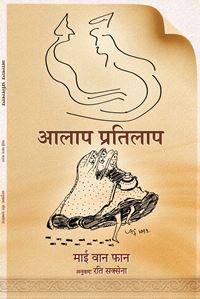आलाप प्रतिलाप 1 / Echo of the Aalap I / Âm vọng của Aalap I (thơ - poetry) - Mai Văn Phấn. माई वान फान. अनुवाद: रति सक्सेना – Rati Saxena dịch sang tiếng Hin-đi
Mai Văn Phấn - माई वान फान
अनुवाद: रति सक्सेना – Rati Saxena dịch sang tiếng Hin-đi

Nhà thơ-Tiến sỹ Rati Saxena

Bìa tập thơ “Âm vọng của Aalap” của Họa sỹ Ajay Kelang
आलाप प्रतिलाप 1 / Echo of the Aalap I / Âm vọng của Aalap(*) I
maivanphan.com: Nhà thơ - Tiến sĩ Rati Saxena vừa gửi tôi tập thơ bằng tiếng Hin-đi, có tên “आलाप प्रतिलाप / Echo of the Aalap / Âm vọng của Aalap”, do Nxb KRITYA - Kerala, Ấn Độ ấn hành vào tháng 2/2016. Theo giải thích của bà, Aalap là bản nhạc không lời, thường được chơi trong âm nhạc cổ điển Ấn Độ, trước khi bài hát bắt đầu. Đây là tập thơ do Rati Saxena tuyển chọn một số bài thơ của tôi từ các bản tiếng Anh (của các Nhà thơ - Dịch giả Trần Nghi Hoàng, Frederick Turner, Susan Blanshard, Pornpen Hantrakool, Lê Đình Nhất - Lang, Nguyễn Tiến Văn) để dịch sang tiếng Hin-đi. Trân trọng cảm ơn Nhà thơ - Tiến sĩ Rati Saxena đã dành thời gian và tâm huyết cho tập thơ của tôi. Xin giới thiệu với Quý Bạn đọc 3 bài thơ (Giai điệu xuân, Con chào mào, Cốm hương) rút trong tập thơ “आलाप प्रतिलाप / Âm vọng của Aalap”.
maivanphan.com: Poet – Dr. Rati Saxena has just sent me a poetry book in Hindi language called “आलाप प्रतिलाप / Echo of the Aalap”, published by KRITYA - Kerala, INDIA I in February, 2016. According to her explanation, Aalap is the musical note without words, usely sung in classic Indian music, before starting the song.... and prati lap means the echo of the Aalap. This poetry book was selected by Poet – Dr. Rati Saxena from some of my poems from English versions (translated by Poet - Translator Trần Nghi Hoàng, Frederick Turner, Susan Blanshard, Pornpen Hantrakool, Lê Đình Nhất – Lang and Nguyễn Tiến Văn) to translate into Hindi language. May I express my sincere thanks to Poet – Dr. Rati Saxena for her time and devotion to my poetry book! I am pleased to introduce to you readers 3 poems (Spring Tone, The Bulbul, The Scent of Cốm) from the poetry book “आलाप प्रतिलाप / Echo of the Aalap”.
बसन्त की धुन
तीखी चट्टान पर
तुम्हारी देह दर्द में थी
अनावृत, कोमलता से बून्द बून्द पिघलती
आवेग की गर्माहट
सूरज की बून्दे तुममें बहती हैं
तमतमाती लहरों के ज्वार में , मौसम लौट रहा है
मधुमक्खियाँ अपनी उड़ान रोक लेती है
हवा सीधी बहने लगती है
मेरी परछाई में लम्बे दरख्त खड़े होने लगे हैं
कबूतर परों को ताने हुए है
ओस से भीगी रात में कीट मकौड़े जगे हुए हैं
कुम्भियाँ अपनी आँखे पूरी तरह खोल
और हरी घास को ढंक रही हैं
बुलबुल
लाल टोपी और सफेद बुन्दकी वाली एक बुलबुल
ऊँचे दरख्त पर गा रही है
ट्विट विट... ट्वी... वू.....
कहीं बुलबुल उड़ ना जाये सोच
मैं विचारों का एक पिंजर गढ़ लेता हूं
लेकिन जैसे ही मेरा पिंजरा तैयार होता है
वह उड़ जाती है, मै धूपीला और हवादार चौखटा थामता हूँ
एक हरी शाख उसका पीछा करती है
उसके विदा होने पर मैं सोचता हूं कि
वह कीड़े चुगने तो जरूर लौटेगी
लाल पके फल
जल की हर बून्द
मेरी पावनता है
ट्विट विट... ट्वी... वू.....
बुलबुल को लौटना है
मैं उसकी चहचहाट सुन रहा हूँ
कोम# की महक
बसन्त शर्माता हुआ लौट आया है
धान पर अस्पष्ट ओस है
वह परिधान, वह स्कार्फ, रेशम सा मुलायम, त्वचा, मेद...
उत्तरी पूर्वी हवा स्वर्ग तक उठती है
कोम# के कूटने की लय, लसदार चावल के फटने का मौसम
टोकरियों से भुस छन रहा है,
धूप के रेगिस्तानों में लाल अंगूरों की महक बस रही है
निर्मलता और प्रफुल्लता गमक रही हैं
बरसात के बाद धरती और आसमान के मध्य हरी कमलनाल एक दूसरे सेलिपटी हैं
ग्रीष्म के मेघों से युक्त अतिपक्व क्षितिज है
दीपशिखा की रोशनी में रात में प्रेमालाप
कोम की निश्छल महक से तेन्दु लसित हो उठे
_________
काम# वह खास तरह का धान हैं जिससे वियतनाम की खास चिपकनेचावल वाली मिठाई बनती है, इस धान की महक बहुत मदमस्त होती है,साथ ही इसे बनाने की प्रक्रिया भी खासी कठिन होती है़
Translated from Vietnamese by Trần Nghi Hoàng
Edited by Frederick Turner
Spring Tone
On the jagged rock
Your dripping body was in pain.
Wide open. Tenderly drop by drop
With passionate warmth
Drops of sunshine flow into you
In a radiant tide, the season returns.
The bee cuts its flight
The wind goes straight up
The tall tree rises up to my shadow.
The dove is fully fledged.
On dewy nights the insects waken.
The straw mushrooms open their eyes
And cover the young with green.
The Bulbul
A bulbul with white spots and a red hat
Sings on the towering tree:
Tee-whit… whit… tee-woo...
Quickly I draw a cage of thought
Afraid the bird will fly away.
Just when I finished the drawing he took off,
I hugged the sunny frame, the windy frame;
As the green bough chased after him.
Of his disappearance without a trace, I thought
Later the bulbul will be back to peck worms,
The ripe red fruit.
Every drop of water
Is my purity
Tee-whit… whit… tee-woo...
The bird needn’t fly back again--
I hear birdsong now, quite clearly.
The Scent of Cốm(*)
Autumn returns in shy
Vague mist upon green rice.
That dress, that scarf, as smooth as silk, the skin, the flesh...
The northeast wind is rising up to heaven.
Rhythm of pounding Cốm, bustling season of the sticky rice:
Baskets slowly sieving out the husk. Ruddy
Fragrant grapefruit moistens the sunny drought.
Pureness the inflorescences ohmantus fragans
Between heaven and earth the lotus tuber after rain
Tormented by a deep longing at each tightening circling roll.
The green lotus leaves are giving succor to you and me,
Over-ripening the horizon clouds of summer
To nights of making love in lamplit silence,
Persimmons drenched with the fragrance of flawless Cốm.
_________
(*) Cốm: green rice flakes, green rice; grilled rice. A Vietnamese special traditional snack make from young sweet rice. Rice growing farmers are the only ones who truly understand when it is time to gather young grains to make Cốm. Then young rice grains are harvested, roasted and ground down to become Cốm. They are put into a large firing pan under small flames and stirred slowly for a specific period of time. They are then poured into a rice mortar and slightly pounded with a wooden pestle, rhythmic pounding and at quick intervals until the husk is removed. Following this, the young rice is removed from the mortar and winnowed before being poured again into the mortar and the process repeated. This is then repeated exactly seven times so that all the husk is removed from the young sticky grains. If the pounding is done irregularly and in haste, or it is not repeated for the prescribed seven times, the green colour of the grains will disappear and be replaced by an unexpected brown colour. Cốm is regarded as a purely pastoral gift. To enjoy Cốm, it is advisable to chew it slowly so that one can feel the stickiness of the young rice and at the same time enjoy its sweet, fragrant taste. Visitors to Vong village (about five km from Hanoi) during the Cốm making season will have a chance to listen to the special rhythmic pounding of wooden pestles against mortars filled with young rice and see women shifting and winnowing the pounded young rice.
Giai điệu xuân
Nhỏ trên đá sắc
Cơ thể em đau
Thánh thót mở toang từng giọt
Trong hơi ẩm nồng nàn
Hạt nắng chảy vào em
Mùa nước về rạng rỡ
Con ong rạch đường bay
Gió lên thẳng đứng
Cây cao vươn bóng anh
Chim bồ câu ra ràng
Sương đêm côn trùng tỉnh dậy
Lũ nấm rơm mở mắt
Trùm lên non nớt xanh
Con chào mào
Con chào mào đốm trắng mũ đỏ
Hót trên cây cao chót vót
triu… uýt… huýt… tu hìu…
Tôi vội vẽ chiếc lồng trong ý nghĩ
Sợ chim bay đi
Vừa vẽ xong nó cất cánh
Tôi ôm khung nắng, khung gió
Nhành cây xanh hối hả đuổi theo
Trong vô tăm tích tôi nghĩ
Lát nữa chào mào sẽ mổ những con sâu
Trái cây chín đỏ
Từng giọt nước
Thanh sạch của tôi
triu… uýt… huýt… tu hìu…
Chẳng cần chim lại bay về
Tiếng hót ấy giờ tôi nghe rất rõ.
Cốm hương
Thu về e ấp
Cốm non lãng đãng sương giăng
Khăn áo ấy mịn màng da thịt
Dâng heo may lên trời
Nhịp cốm giã rộn mùa thóc nếp
Thúng mủng dần sàng vỏ trấu hây hây
Trái bưởi thơm dịu nắng hanh
Thanh khiết chùm hoa mộc
Giữa đất trời ngó sen sau mưa
Da diết nhớ từng vòng cuộn xiết
Lá sen xanh ủ cốm em anh
Chín nẫu chân mây mùa hạ
Đêm ái ân lặng phắc ngọn đèn
Trái hồng đượm trong hương cốm nõn.
_______
(*) Aalap là bản nhạc không lời, thường được chơi trong âm nhạc cổ điển Ấn Độ, trước khi bài hát bắt đầu.

Bìa 1 & 4 tập thơ “Âm vọng của Aalap” của Họa sỹ Ajay Kelang